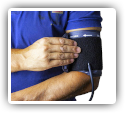Blood Pressure Values Improved Under Chiropractic Care - A Case Study
Print Article

The Journal of Upper Cervical Chiropractic Research published the results of a case study on August 4, 2023, documenting the improvement in hypertension of an elderly patient receiving chiropractic care.
The authors of the study begin by noting that "Hypertension is the most common primary diagnosis in the United States and a major risk factor for cardiovascular disease." They further note that "Approximately 77.9 million people, or 1 out of every 3 people have high blood pressure in the U.S."
Under normal function, the human body should be able to control blood pressure using internal mechanisms. The authors explain the situation when the body is no longer controlling blood pressure normally. "Patients experiencing high blood pressure have in one way or another exhausted their natural internal controls. The human body has regulatory mechanisms in place to control blood pressure ensuring proper blood flow to all organs and tissues."
In this case, a 77-year-old woman decided to go to the chiropractor. The woman had previously been diagnosed with hypertension. She was on medication for five years but was still having difficulty controlling her blood pressure. The woman reported that she was involved in a car accident 25 years earlier but suffered no injuries. She also stated that she had polio and spinal meningitis in 1952.
A chiropractic examination was performed which included a postural analysis, spinal palpation, leg length measurements, weight distribution and cervical spine x-ray. The purpose of the examination was to determine if subluxation was present in the upper cervical spine. Previous research has linked subluxations in the upper neck to blood pressure issues. From this examination and x-ray, it was determined that subluxation was present in the top bone of the neck, known as the atlas.
Specific forms of chiropractic care were started to correct the subluxation. On each chiropractic visit, a determination was made about the presence of subluxation and the need for an adjustment. The patient kept a daily journal of her blood pressure, and her blood pressure was monitored on each chiropractic visit. The study reports that as the woman’s care continued, she was able to realize a 12% reduction in systolic blood pressure reading and 13% reduction in diastolic reading. The study notes that the woman continued her chiropractic care and was able to discontinue one of her blood pressure medications while still maintaining a lowered blood pressure.
In the authors’ discussion and conclusions, they stated, "Evidence within the chiropractic literature supports the positive effects of the chiropractic adjustment on hypertension." They further say, "The 77-year-old patient who experienced such a dramatic decrease in her blood pressure is a powerful example of how hypertensive patients could benefit from chiropractic care."
Print Article


